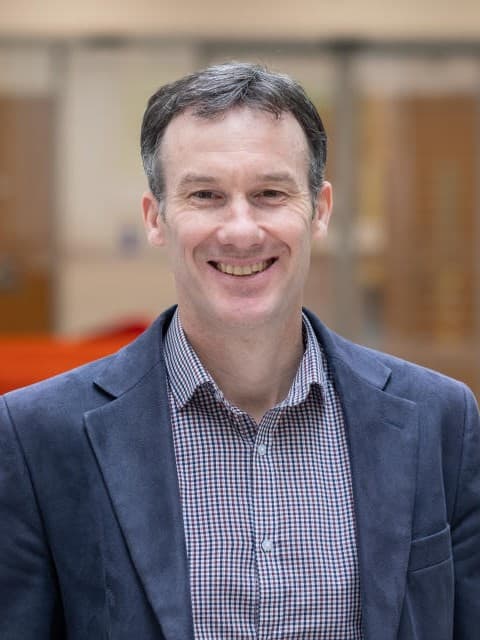Professor Folland graduated with a bachelor’s degree (BSc in Sport & Exercise Science, Loughborough University) and a PhD (Exercise Physiology, University of Birmingham). Following teaching and research positions in physiology and biomechanics at three Universities (Brighton, Massey and Salford) he returned to Loughborough as academic staff in 2004, being appointed a full professor in 2017.
Jonathan’s teaching, research and consultancy work is focused on physical performance, fitness and training, and especially neuromuscular function, principally strength and power, as well as the underlying physiology and biomechanics that explain function. This topic has applications to athletic performance, sports injury and human health. Jonathan’s teaching involves leading the MSc module in ‘Neuromuscular Function’ as well as co-ordinating MSc projects.
He is a Fellow of the American College of Sports Medicine and the Royal Society of Biology, and Deputy Director of the Versus Arthritis Centre for Sport, Exercise and Osteoarthritis Research. Jonathan is interested in a range of sports, but particularly athletics/running and football from a scientific perspective, as well as having a lifelong interest in canoeing and kayaking, having competed and coached at international level.
Jonathan has authored >110 peer reviewed research papers in world-leading physiology, sports science and medicine journals. He has been principle (lead) investigator on externally funded projects worth >£1.6M and co-investigator on projects of >£6M.
Research primarily addresses the measurement, determinants, and effects of exercise (i.e. responses and adaptations) on neuromuscular function (strength and power) in athletes, recreational exercisers, older adults and patient groups. The goals of this research are to understand the characteristics that determine neuromuscular performance and the plasticity of these characteristics in response to interventions (training) in order to enhance performance. Major research themes include:
- Assessment, determinants and training of explosive function and performance (rate of force development, power)
- Adaptations to resistance training
- Muscle morphology in relation to function and injury
- Neuromuscular phenotyping and exercise for older adults and osteoarthritis patients
- Neuromechanics of running
Current Research Funders
- Versus Arthritis Centre for Sport, Exercise & Osteoarthritis Research
- STATS Perform
- British Athletics
- Versus Arthritis
- Defence Police Federation
Example PhD completions
- Robert Miller: The muscle morphology of sprinters. December 2021.
- Jasmin Willer: Lower-limb neuromechanics of high-intensity running with special reference to fatigue, and their implications for middle-distance performance. December 2020.
- Chris Hartley: The effect of high impact exercise on imaging biomarkers of osteoporosis and osteoarthritis in postmenopausal women. January 2020.
- Patrick Wheeler: The medical management of patients with chronic plantar fasciitis. October 2019.
- Marcel Lanza: Neural contributions to maximal motor performance. October 2018.
- Fearghal Behan Neuromechanics of Explosive Performance for Movement Control and Joint Stabilisation. December 2017.
- Garry Massey: Muscle-tendon unit morphology, architecture and stiffness in relation to strength and responses to strength training. December 2016.
Jonathan has done consultancy work and provided expertise on fitness, physical training and athletic performance with a wide range of industry (Technogym, MAS Holdings, BBC) and sports organisations (British Athletics, Leicester Tigers) for a total consultancy income of >£180,000.
To request consultancy and enterprise with Dr Folland please contact the Enterprise Office.
Jonathan is an Associate Editor for the world leading sports science journal Medicine and Science in Sports and Exercise.
Featured publications
- Folland JP, Balshaw TG (2021). Muscle growth does contribute to the increases in strength that occur after resistance training. Med Sci Sports Exerc 53(9):2006-2010.
- Balshaw TG, Maden-Wilkinson TM, Massey GJ, Folland JP (2021). The Human Muscle Size and Strength Relationship: Effects of Architecture, Muscle Force, and Measurement Location. Med Sci Sports Exerc 53(10):2140-2151.
- Miller R, Balshaw TG, Massey GJ, Maeo S, Lanza MB, Johnston M, Allen SJ, Folland JP (2021). The Muscle Morphology of Elite Sprint Running. Med Sci Sports Exerc, 53(4):804-815.
- Willer J, Allen SJ, Burden RJ, Folland JP (2021). Neuromechanics of Middle-Distance Running Fatigue: A Key Role of the Plantar Flexors? Med Sci Sports Exerc 53(10):2119-2130.
- Maden-Wilkinson TM, Balshaw TG, Massey GJ, Folland JP (2020). What makes long-term resistance-trained individuals so strong? A comparison of skeletal muscle morphology, architecture, and joint mechanics. J Appl Physiol, 128(4):1000-1011.
- Del Vecchio A, Negro F, Holobar A, Casolo A, Folland JP, Felici F, Farina D (2019). You are as fast as your motor neurons: Speed of recruitment and maximal discharge of motor neurons determine the maximal rate of force development in humans. J Physiol 57(9): 2445-2456.
- Tillin NA, Pain MTG, Folland JP (2018). Contraction speed and type influences rapid utilisation of available muscle force: neural and contractile mechanisms. J Exp Biol 10;221(Pt 24).
- Folland JP, Allen SJ, Black MI, Handsaker JC, Forrester SE. (2017). Running technique is an important component of running economy and performance. Med Sci Sports Exerc 49(7): 1412-1423.
